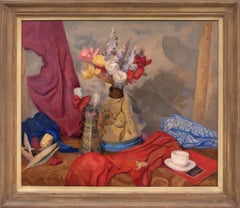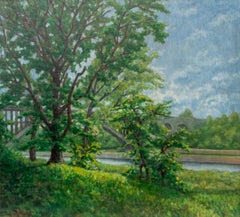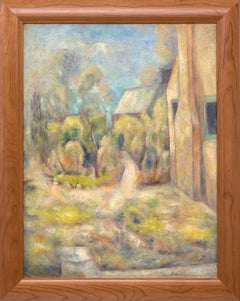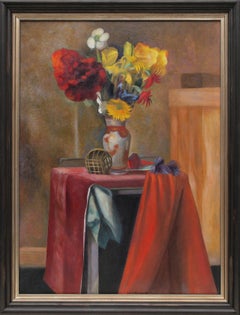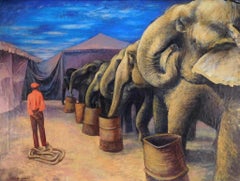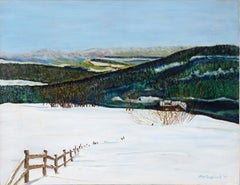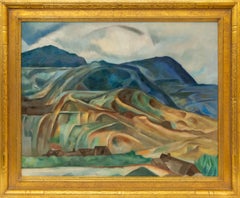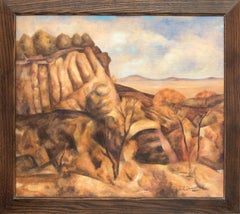Oil on canvas laid on board painting titled "Untitled (Colorado Mesa and Trees)" by John E. Thompson (1882-1945). A semi-abstract painting of a Colorado landscape, painted in shades of purples, yellows and browns. Presented in a wood frame, outer dimensions measure 32 x 36 x ⅜ inches. Image sight size is 27 ¼ x 31 ¾ inches.
About the Artist:
Thompson’s professional career as an artist and art educator is largely associated with Denver and Colorado where he lived and worked for more than thirty years. While he may not have achieved a commanding national profile, his well-informed and unceasing efforts as the Dean of Colorado Artists in the first half of the twentieth century introduced modernity into Colorado art and art education, making it possible for all types of good art to be seen and appreciated.
Producing his first drawings at age fourteen for a Professor Berger in his hometown, Thompson thereafter enrolled in the Art Students League of Buffalo, studying with Lucius Hitchcock, one of America’s noted illustrators. During that time he befriended artist George Carlock, nephew of Elbert Hubbard who headed the famous Roycroft Colony near East Aurora, New York, where they sketched and painted on the weekends. Thompson also developed his skill in bag-punching, later earning him extra money while studying in Paris.
The four Sherwood Smith money prizes he won for his life-class drawings in Buffalo enabled him to attend the Art Students League in New York for two years, beginning in 1899, where he studied with Frank Vincent DuMond. He also won a scholarship in drawing to the Chase School of Art (also known as the New York School of Art) where he was monitor of Hitchcock’s illustration class. The money he earned from illustration work in New York helped finance his trip to Europe where in the spring of 1902 he studied with Myron Barlow, an American based in Étaples in northern France. The atmosphere of the fishing port -- also an international art colony at the time -- introduced Thompson to the color and life of France.
In November 1902 he entered the Académie Julian in Paris, working under Jean-Paul Laurens, Henri Royer and Marcel Baschet who imparted a healthy respect for sound draughtsmanship. Among his classmates were Sheldon Cheney, American author on art and the theater, and Anton Otto Fischer, German-born illustrator and later Howard Pyle’s student in the United States. During his second year abroad Thompson spent his mornings at Julian’s and his afternoons at the Académie La Palette, directed by Jacques-Émile Blanche who attracted many British and American students seeking exposure to the latest avant-garde trends. He benefitted from the critiques of Charles Cottet, Lucien Simon and Edmond Aman-Jean with whom Birger Sandzén also studied in Paris.
In the spring of 1904 Thompson left for Holland, spending the next year and a half in the painting village of Laren near Amsterdam where he met Johannes Albert Neuhuys, one of the best known painters of the Laren School, and the celebrated genre painter, Jozef Israӫls, with whom he studied. During that time Thompson had two of his paintings accepted for the 1904 exhibition of the Société des Artistes Français.
Returning to Paris in July 1905 he briefly studied again at the Académie Julian and Académie La Palette before breaking with the academic style to pursue independent study at the Louvre and other Paris museums. There he assimilated diverse art forms including classical mosaics and murals, Persian miniatures, Old Master drawings and paintings, as well as the work of Daumier, Renoir, Toulouse-Lautrec and Van Gogh. He visited Gertrude Stein’s salon and viewed the Fauves’ work at the 1905 Salon d’Automne and the Cézanne retrospective at the 1907 Salon that greatly influenced his own creative output. Reexamining all that he had learned from a new perspective, he began developing his own vision, melding Cézanne’s color planes with the traditional art he loved. He considered Cézanne’s work a “belated return of art to the classicism of the old masters” and their concern with structural qualities, form, line and color.
Thompson and Carlock became Thomas Hart Benton’s first two American friends after he arrived in Paris in 1907 to study at the Académie Julian, as noted in Tom Benton’s America: An Artist in America. Carlock introduced Thompson to the great English color scientist, Percival Tudor-Hart. Working in his atelier from 1905 to 1908, he received a thorough grounding in composition research and color theory and also learned to think constructively for himself. For a time he painted scintillating color landscapes at Chezy-sur-Marne near Chateau Theirry. Thereafter he lived for six months at the home of the novelist George Sand at Gargilesse-Dampierre where he produced Impressionist style canvases. After 1908 he worked independently, taking painting trips to Martigues, Aix and Marseilles in the south of France. He also traveled to England, Spain and Italy, studying important public art collections in those countries.
At the outbreak of World War I he returned to Buffalo, New York, to await a quick end to the hostilities that did not materialize. Eager to paint and intrigued by railroad folders describing the light and rugged country in Colorado, he traveled to the state in 1914 where he spent about seven months at Shaffers Crossing and Pine in the mountains west of Denver. Among the images he produced there was Pine, Colorado. Reflecting his exposure to Post-Impressionism in Europe and stylistically very different from most of the art being produced in Colorado at that time, the painting has a certain freedom and minimum of detail combined with a sound structural base characterizing his work over the next thirty years. In addition to falling in love with the Colorado landscape in 1914, he met his future wife Harriette C. Brown, whom married the following year and returned to Buffalo.
His European credentials gained him several students of Polish heritage in Buffalo – Józef Bakoś, Alexander Korda and Walter Mruk. They followed him to Denver after he relocated there with his wife in 1917. Bakoś and Mruk later moved to Santa Fe where along with Fremont Ellis, Willard Nash and Will Shuster they became two of the founding members of Los Cinco Pintores (The Five Painters), the city’s first modernist art group. In the mid-1920s Thompson comprised part of the summer school faculty at the Santa Fe Art School that included Bakoś and Mruk, as well as Andrew Dasburg, B.J.O. Nordfeldt and Walter Ufer.
Seeking to educate the public in the fine arts, Thompson and his young students introduced modernism to Colorado in 1919 at the twenty-fifth annual exhibition of the Denver Art Association. It quickly became known as the Denver Armory Show because it generated similarly vituperative polemics in the local press as did the Armory Show held six years earlier in New York. Thompson’s painting, Organization of Rocks and Trees, was ridiculed by Horace Simms in the Rocky Mountain News as reflecting “downright idiocy of conception.” Some critics in the local press even went so far as to label the artist a “Bolshevik.”
He successfully weathered the storm, going on to teach for a time in the early 1920s at the Denver Academy of Fine and Applied Arts along with Laura Gilpin, Anne Van Briggle Ritter, Arnold Rönnebeck and Paul St. Gaudens. After he resigned, a group of students – among them Donald Bear, Josephine Hurlburt, Charles F. Ramus and
Frank Vavra...
